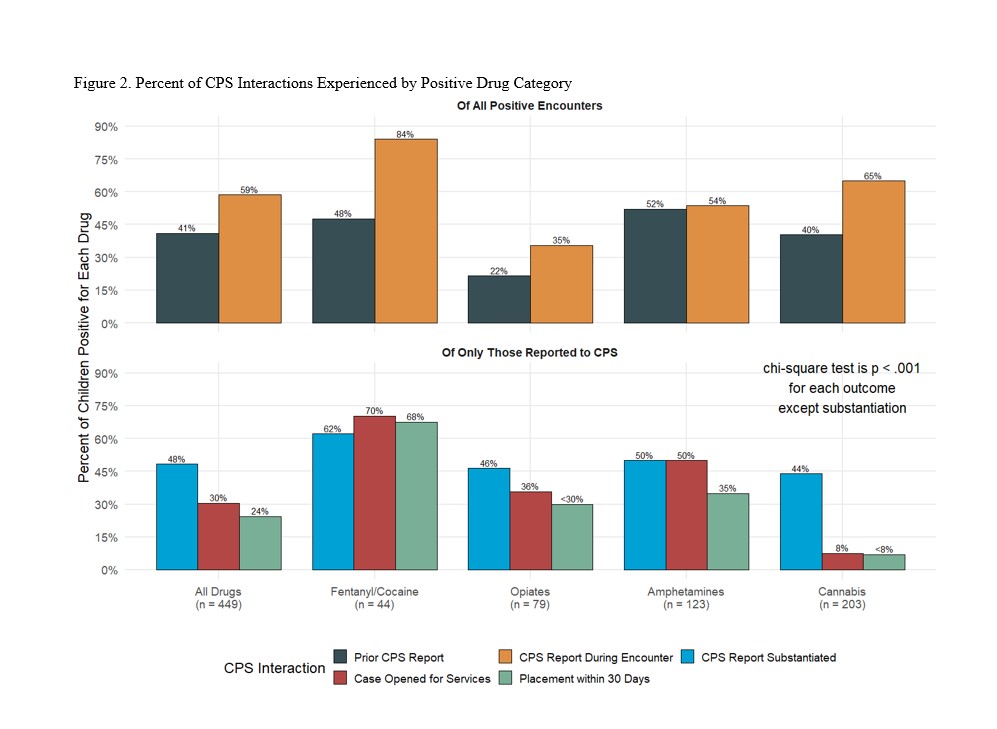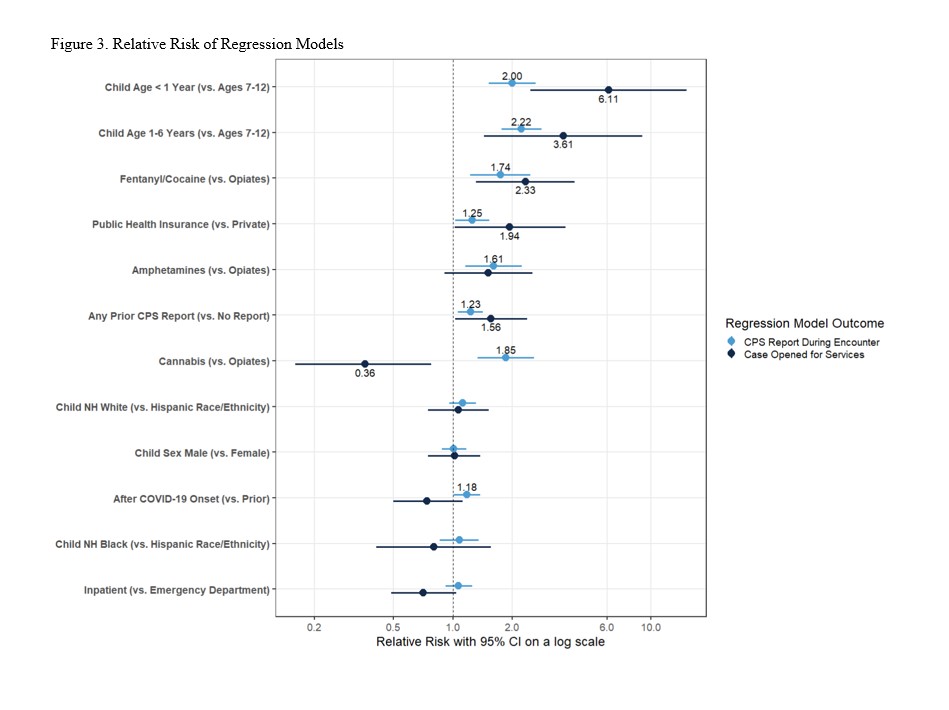Back
Background: Young children are ingesting illicit drugs at increased rates, but it is unknown what the associated child protection system (CPS) outcomes are when a young child tests positive.
Objective: Our objective was to understand the CPS outcomes and characteristics of children who test positive for illicit drugs. Our hypothesis was there would be variability in outcomes depending on drug type. We were specifically interested in outcomes related to cannabis ingestion as it is recreationally legal for adult use in the state of California
Design/Methods: This was a retrospective cross-sectional study of linked medical discharge and CPS administrative data. We included children less than 12 years of age with positive urine drug screens at a large free standing children’s hospital. We excluded children who had prescriptions for amphetamines, opiates, or cannabis. CPS outcomes were probabilistically linked with the medical encounter to include CPS reports, substantiations, case openings and out of home placements. Statistical analysis included descriptive statistics and multiple regression models with robust error variance. The first model estimated the risk of a CPS report during the medical encounter associated with the positive drug test. The second model estimated, for only encounters reported to CPS during the medical encounter, the risk of CPS opening a case for services beyond the investigation.
Results: A total of 449 ED and inpatient medical encounters had a positive urine drug test, 60% of were reported to CPS, and of those, 24% were placed out-of-home within 30 days. Two-thirds of children were age 6 years or younger and 72% were on public insurance. 41% of children with positive urine drug screens had a prior CPS report. Cannabis was the most frequent substance identified on urine drug screens (48%) followed by Methamphetamine (33%). There were statistically significant differences in the distributions of CPS outcomes by drug type. Out of home placement occurred most frequently in fentanyl exposures (68%). Notably for those children who tested positive for cannabis, CPS substantiated abuse/neglect 44% of the time. Out of home placements were rare for cannabis but did occur (8%).
Conclusion(s): This study highlights the variability that exists in reporting practices and CPS outcomes when a child tests positive for a drug. There appears to be opportunity for early intervention as many children had prior CPS cases open before their positive urine drug screen. Clinicians and CPS should standardize their approach to reporting and investigating cannabis ingestions in young children



Child Abuse & Neglect
Session: Child Abuse & Neglect 1
172 - Child Protective Services Outcomes for Children who have Positive Urine Drug Screens for Illicit Drugs
Saturday, May 4, 2024
3:30 PM – 6:00 PM ET
Poster Number: 172
Publication Number: 172.1558
Publication Number: 172.1558
- NL
Natalie Laub, MD (she/her/hers)
University of California, San Diego School of Medicine
San Diego, California, United States
Presenting Author(s)
Background: Young children are ingesting illicit drugs at increased rates, but it is unknown what the associated child protection system (CPS) outcomes are when a young child tests positive.
Objective: Our objective was to understand the CPS outcomes and characteristics of children who test positive for illicit drugs. Our hypothesis was there would be variability in outcomes depending on drug type. We were specifically interested in outcomes related to cannabis ingestion as it is recreationally legal for adult use in the state of California
Design/Methods: This was a retrospective cross-sectional study of linked medical discharge and CPS administrative data. We included children less than 12 years of age with positive urine drug screens at a large free standing children’s hospital. We excluded children who had prescriptions for amphetamines, opiates, or cannabis. CPS outcomes were probabilistically linked with the medical encounter to include CPS reports, substantiations, case openings and out of home placements. Statistical analysis included descriptive statistics and multiple regression models with robust error variance. The first model estimated the risk of a CPS report during the medical encounter associated with the positive drug test. The second model estimated, for only encounters reported to CPS during the medical encounter, the risk of CPS opening a case for services beyond the investigation.
Results: A total of 449 ED and inpatient medical encounters had a positive urine drug test, 60% of were reported to CPS, and of those, 24% were placed out-of-home within 30 days. Two-thirds of children were age 6 years or younger and 72% were on public insurance. 41% of children with positive urine drug screens had a prior CPS report. Cannabis was the most frequent substance identified on urine drug screens (48%) followed by Methamphetamine (33%). There were statistically significant differences in the distributions of CPS outcomes by drug type. Out of home placement occurred most frequently in fentanyl exposures (68%). Notably for those children who tested positive for cannabis, CPS substantiated abuse/neglect 44% of the time. Out of home placements were rare for cannabis but did occur (8%).
Conclusion(s): This study highlights the variability that exists in reporting practices and CPS outcomes when a child tests positive for a drug. There appears to be opportunity for early intervention as many children had prior CPS cases open before their positive urine drug screen. Clinicians and CPS should standardize their approach to reporting and investigating cannabis ingestions in young children



